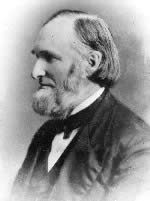- George Frederick Magoun
Infobox President
name = George Frederick Magoun
order = 1st
office= President of Iowa College
term_start = 1865
term_end = 1885
predecessor = Trustees ofIowa College
successor =Samuel J. Buck (acting)George Augustus Gates (1887)
birth_date = 1821
birth_place =Bath, Maine
death_date = January 30, 1896
death_place =Grinnell, Iowa
spouse = Elizabeth Earle Magoun
alma_mater =Bowdoin College , 1841;Andover Seminary , 1847
religion=Congregationalist George Frederick Magoun (
1821 –January 30 ,1896 "Obituaries", "The New York Times". January 31, 1896. Available from [http://query.nytimes.com/gst/abstract.html?res=FA0F17FF3F5F1B738DDDA80B94D9405B8685F0D3 New York Times archives] ] ), a member of theIowa Band ofCongregationalist ministers, was the first president ofIowa College (now Grinnell College), where he served as college president from 1865 to 1885.Grinnell College Libraries. [http://www.lib.grinnell.edu/collections/specialcollections/VirtualExhibits/Presidents.html Presidents of Grinnell College] . AccessedMay 10 ,2008 .]George Magoun was born in
Bath, Maine in 1821, where he attended Bath Academy before enteringBowdoin College . He graduated from Bowdoin in 1841. After Bowdoin, he taught at schools inGalena, Illinois andPlatteville, Wisconsin from 1844-1846. Magoun continued his studies atAndover Seminary and completed his divinity degree in 1847.Now an ordained
Congregationalist minister, Magoun and other members of theIowa Band moved to the Midwest to establish congregations. Magoun led congregations inDavenport, Iowa andLyons, Iowa , also studying law inBurlington, Iowa . He became a founding trustee ofIowa College , then located in Davenport. In 1854 and 1855, as the town's relations with the college worsened, Magoun and other trustees pushed to move to the new town ofGrinnell, Iowa . At the end of the Civil War in 1865, Magoun was inaugurated as the college's first president.Jones, Alan. [http://web.grinnell.edu/hlc/ncafinal1998.pdf "A Brief History of Grinnell College"] , pp. 10-17. AccessedMay 10 ,2008 .]Magoun was a liberal president, permitting the teaching of
evolution despite his personal disagreement with Darwin's work. As the first college president, he attempted to realize his vision for a college in the West:The best cure for 'prairie-mindedness' is found in that spiritual-mindedness which creates scholars because it requires a knowledge of the deep things of our own nature and of God... A College prompts to great moral enterprise, nay it is itself a great moral enterprise.
In 1870, George Magoun married Elizabeth Earle, an 1860 graduate of
Mount Holyoke Seminary who taught at Mount Holyoke from 1860 to 1867.Five Colleges Archives Digital Access Project. [http://clio.fivecolleges.edu/mhc/stow/ch22.htm Stow, "History of Mount Holyoke Seminary"] , "Chapter XXII: Catalogue of Officers of Mount Holyoke Seminary, of Anniversary Speakers, and of Pastors", p. 350. AccessedMay 10 ,2008 ] In Grinnell, Elizabeth Earle Magoun was one of the founders of the town's oldest women's club, the "Busy Woman's Club", founded in 1870 and renamed in honor of Mrs. Magoun in 1896. [Grinnell College Libraries. [http://www.lib.grinnell.edu/collections/specialcollections/Manuscripts/findingaids/MagounMss.html Magoun Club Records] . AccessedMay 10 ,2008 .]During Magoun's tenure as president, the college grew significantly; in 1882, there were two buildings and nearly 400 students. Despite a cyclone that year that destroyed the campus and killed two students, by the time of Magoun's 1884 retirement, three new buildings had been built.
George Magoun was succeeded by
George A. Gates in 1887; Professor ofMathematics and Natural Philosophy Samuel J. Buck served as interim president from 1884 to 1887.After his retirement as college president, Magoun took a professorship in Mental and Moral Science at Iowa College, teaching from 1884 to 1890.
Chicago Hall, on the Grinnell College campus, was renamed Magoun Hall in memory of President Magoun. Magoun Hall, which stood near the present buildings of the
Bucksbaum Center for the Arts and Burling Library, was demolished in 1959. [Conard, Henry S. and Larissa Mottl. (1927 and 2003) Grinnell College, Center for Prairie Studies. [http://web.grinnell.edu/cps/Resources/our_trees.pdf "Our Trees: A Guide to Trees in Grinnell"] pp. 100-101]References
Wikimedia Foundation. 2010.
